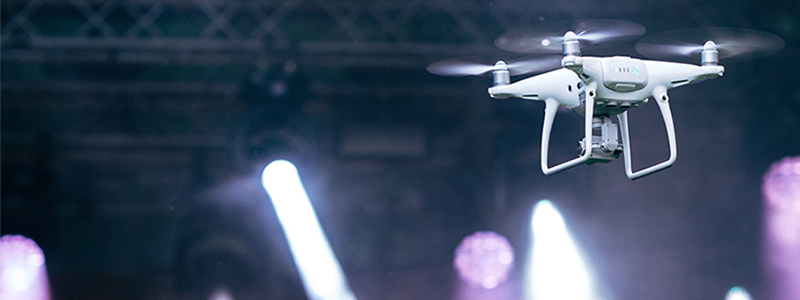Drones appear to be a logical next step for video surveillance, however, their adoption in the industry has been slow. BCDVideo Vice President, Tom Larson, discusses the viability of robotics and drones for video surveillance and the challenges they need to overcome to see widespread acceptance.
Robotics and Drones in Video Surveillance
Today, we don’t see a lot of adoption into the video surveillance industry. There have been some cool products that have hit the industry in the last year. One is actually a drone detector. We see those deployed at prisons because there’s an issue with people using them to fly things into the prisons.
A bigger fit, though, is using drones in a mall environment. Instead of deploying 40-50 cameras in a parking lot area, we can put tethered drones in the air shooting high-definition video back to the command center within the mall. Another use is a rapid deployment situation such as a music festival. Putting drones up in the air above the festival for crowd control is probably something we’re going to see more and more.
As far as robotics, I’ve seen the robotic security guard. There are two or three manufacturers marketing it to the space. There will be some challenges with this approach because it replaces a human. That can be sensitive to a corporation looking to adopt this technology.
Where will Biometrics be in a Year?
We’ll see more because of cybersecurity and the need to secure buildings. We will see a lot more two-factor authentication. To get into sensitive areas of the building, you may need to use a biometric scanner on top of using an access control card. I think you will see more and more of that type of solution being used.
What are the Main Challenges with Biometrics?
There are not a lot of companies in our space doing it and doing it well. As more people are looking for it, there are limited vendors offering biometrics.
How are Biometrics and Analytics Being Used?
Analytics is really erupting in the market, more so than biometrics. There are only so many biometric options being used: fingerprint, iris… so there are limitations. Being with iris, you have to literally put your head up to a goggle to grab a reading.
Analytics is something that is more relevant and erupting very quickly because we are, in some ways, adapting analytics that Google may be using it for other things. Or you see technology that Facebook is using where it’s identifying people in pictures. We’re taking that technology and adapting for video surveillance. Now, our analytics are very accurate.
We have an incredible amount of video data, in the neighborhood of 1000 Petabytes a day being recorded around the world. How do we search for it? A human cannot search that. There’s just too much data, so we need to run analytics through that video to produce quality searches.
What are More Uses for Video Analytics?
We can look at data over a seven day period and ask the system to produce all red cars that went through a gate. Within seconds, it produces a bunch of clips of all the red cars that went through the gate in the last seven days. From there they can review it very quickly and find what they were looking for. Other uses include people counting. How many people were on the scene? How many people left? Alerts can be set based on that.
License plate reading is another use. We see that a lot in the trucking industry. We have high volumes of trucks coming in and out of distribution centers. It gets log jammed if a human has to check the plates to check them all in. If the semis’ plates are in the system already, we know when that semi should be arriving and can even tell the driver which dock to go use all without human intervention.
How can Biometrics and Analytics work Together?
If you have biometric data for a person and analytics, you can use those as a crosscheck. For example, everyone has a driver’s license. That photo is in a database that can be used to crosscheck people’s faces going through an airport.
How has Security adapted to Video Analytics?
Simple analytics has shifted to be run in the cameras which are driving the cost down. Some of the advanced analytics still have to be run on a server. This costs quite a bit. As cameras become more powerful, that will allow more complex analytics to be run in the camera. At some point, every camera will have analytics built in. Instead of simply being an imager, cameras will be an imager with advanced features already built in at a reasonable cost.
To watch more interviews with BCDVideo team members, check out the links below:
Challenges in Security – BCDVideo Server and Storage Specialist, Adam Janic
What Makes a Great Leader? – BCDVideo President/CEO, Jeff Burgess
How to Determine Network Security – Mike Wagner
Standard or Fad: Mobile Security – BCDVideo Vice President, Tom Larson
Standard or Fad: Cloud Storage – BCDVideo Vice President, Tom Larson
Challenges in Cybersecurity – BCDVideo Vice President, Tom Larson
The State of Biometrics and Analytics – BCDVideo Vice President, Tom Larson

